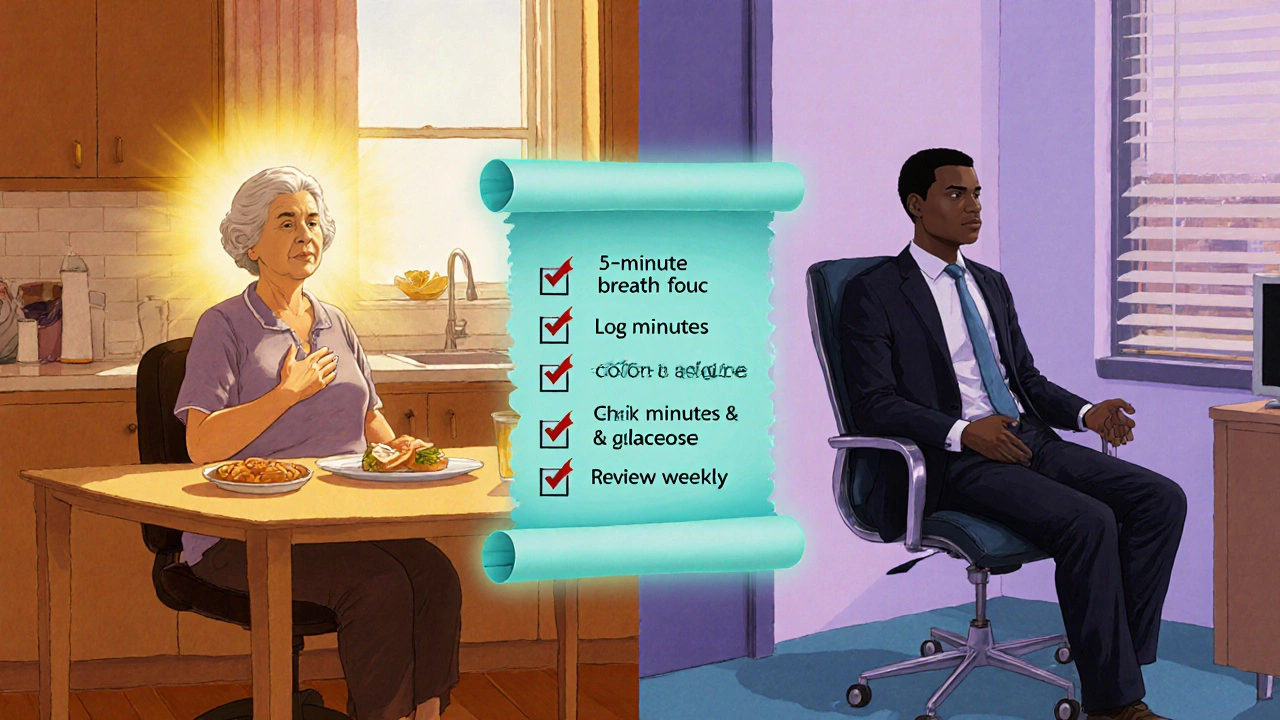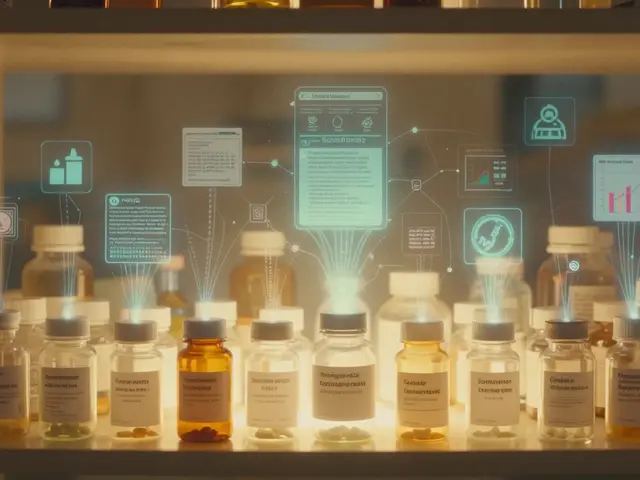HbA1c Reduction Estimator
Based on research showing that consistent mindfulness meditation can reduce HbA1c levels by 0.3-0.5 percentage points over 8-12 weeks. This estimator uses the average reduction of 0.4 percentage points for your calculations.
Calculate Your Potential HbA1c Reduction
Estimated Results
Based on research showing a 0.4 percentage point reduction with consistent practice over 8-12 weeks. Individual results may vary.
When it comes to controlling type 2 diabetes - a chronic condition where the body resists insulin - many turn to medication and diet. Type 2 diabetes is characterized by elevated blood glucose levels and often requires lifelong management, lifestyle tweaks can make a huge difference. One practice that’s gaining scientific backing is mindfulness meditation. Mindfulness meditation is a mental training technique that encourages present‑moment awareness without judgment. Below we explore why this simple habit matters for blood‑sugar control, heart health, and overall well‑being.
How mindfulness meditation talks to the body’s glucose system
Stress spikes cortisol, a hormone that tells the liver to release extra glucose. When stress becomes chronic, cortisol stays high, and the body’s cells become less responsive to insulin - a key driver of insulin resistance. Mindfulness meditation reduces the brain’s alarm system, lowering cortisol levels and, in turn, easing the pressure on insulin.
Several studies published after 2020 measured HbA1c (the average blood‑sugar level over three months) before and after an eight‑week mindfulness program. Participants saw reductions of 0.3-0.5 percentage points, comparable to modest medication adjustments.
Key physiological benefits backed by research
- Lower cortisol: A 2022 randomized trial showed a 22 % drop in morning cortisol after just ten minutes of daily meditation.
- Improved heart‑rate variability (HRV): Higher HRV signals a balanced autonomic nervous system, which helps regulate glucose metabolism.
- Enhanced neuroplasticity: Mindfulness can reshape brain circuits that control cravings, making it easier to stick to a low‑glycemic diet.
- Better sleep quality: Quality sleep reduces insulin resistance; meditation often adds an extra hour of restorative sleep per week.
Integrating meditation into a diabetes‑friendly routine
- Set a realistic goal: Start with 5 minutes of guided breathing each morning.
- Choose a consistent time-right after checking your blood glucose or before a meal.
- Use a reputable app or a local class; the American Diabetes Association recommends programs that include stress‑management components.
- Track progress: Log meditation minutes alongside glucose readings in a journal or digital tracker.
- Gradually extend sessions to 15-20 minutes, adding body‑scan or loving‑kindness meditations as you feel comfortable.
Consistency beats duration. Even a short, daily habit can create measurable changes in blood glucose trends.

Mindfulness versus traditional stress‑relief methods
| Aspect | Mindfulness Meditation | Typical Stress‑Relief (e.g., medication, alcohol) |
|---|---|---|
| Effect on cortisol | ↓ 20‑30 % (studies 2021‑2024) | Variable; may ↑ with substances |
| Impact on HbA1c | ↓ 0.3‑0.5 % | Neutral or ↑ if stress persists |
| Side effects | Minimal; occasional frustration | Potential drug interactions, dependence |
| Cost | Free‑to‑low (apps, online videos) | Prescription or out‑of‑pocket costs |
While medication remains essential for many, mindfulness offers a low‑risk, cost‑effective complement that tackles the root stress response.
Real‑world stories that illustrate the impact
Case 1 - Sarah, 58, retired teacher: After a diagnosis, her HbA1c hovered at 8.2 %. She added a 10‑minute mindfulness routine before breakfast. Six months later, her reading dropped to 7.4 % and she reported fewer evening cravings.
Case 2 - Jamal, 45, small‑business owner: Long work hours kept his stress high. A workplace wellness program introduced a weekly 30‑minute guided meditation. Over a year, his fasting glucose fell from 140 mg/dL to 115 mg/dL, and his blood pressure improved as well.
Both examples underline that the practice isn’t a magic bullet but a steady ally in everyday diabetes management.
Common pitfalls and how to avoid them
- Skipping consistency: Missing days erodes the hormonal benefits. Set a reminder.
- Expecting instant glucose drops: Benefits accumulate over weeks, not days.
- Choosing the wrong environment: Noisy, distracting spaces can increase stress instead of reducing it.
- Ignoring medical advice: Meditation isn’t a substitute for insulin, oral meds, or regular check‑ups.
Pair meditation with a balanced diet, regular physical activity, and routine doctor visits for the best outcomes.

Quick checklist for busy adults
- Find a quiet spot - bedroom, office, or park bench.
- Set a timer for 5‑10 minutes.
- Focus on breath; notice thoughts without judging.
- Log minutes and glucose readings together.
- Review trends weekly; adjust duration if needed.
Even a modest commitment can shift the stress‑glucose axis in your favor.
Frequently Asked Questions
Can mindfulness meditation replace my diabetes medication?
No. Meditation is a complementary tool. It can lower stress‑related glucose spikes, but you still need to follow your doctor’s medication plan.
How soon can I see a change in my blood‑sugar numbers?
Most studies report noticeable HbA1c improvements after 8-12 weeks of consistent practice. Short‑term glucose variability may improve within a few days.
Do I need a special meditation app for diabetes?
Any guided meditation that teaches breath awareness works. Look for programs that mention stress reduction, cortisol, or blood‑sugar support.
Is there a risk of hypoglycemia from meditation?
Meditation itself does not lower glucose directly; it mainly reduces spikes caused by stress. Hypoglycemia risk remains tied to medication and diet, not the practice.
Can I combine mindfulness with other mind‑body practices?
Absolutely. Yoga, tai chi, or progressive muscle relaxation can enhance the stress‑reduction effect. Just keep the total daily time realistic for your schedule.
Next steps for you
Pick a 5‑minute guided breathing video on YouTube today. Sit comfortably, set a timer, and focus on the rise and fall of your chest. Record the minutes in your diabetes log and note any immediate changes in mood or appetite. Revisit the log after a month; you’ll likely see a smoother glucose curve.
Remember, the power of mindfulness lies in regular, gentle attention. Pair it with the fundamentals-balanced meals, regular exercise, and prescribed meds-and you’ll give your body the best chance to keep blood sugar in check.







Comments
sravya rudraraju
19 October 2025Integrating mindfulness into a diabetes management plan constitutes more than a simple lifestyle tweak; it represents a structured approach to modulating the neuroendocrine pathways that govern glucose homeostasis. By consistently allocating a few minutes each day to breath‑focused awareness, individuals create a physiological buffer against the cortisol surges that commonly accompany post‑prandial stress. This buffer, in turn, diminishes hepatic glucose output, thereby allowing insulin to perform its intended function with greater efficiency. The literature, particularly studies from 2021 onward, corroborates a measurable decline in HbA1c values when meditation is practiced for a minimum of eight weeks. Moreover, the improvement in heart‑rate variability observed in randomized trials signals a balanced autonomic nervous system, which further supports metabolic stability. When the parasympathetic branch predominates, peripheral tissues become more receptive to glucose uptake, reducing the demand on pancreatic beta‑cells. In practical terms, this translates to fewer medication adjustments and a smoother glucose curve on daily logs. An additional benefit lies in the enhancement of sleep architecture, as nighttime meditation can extend deep‑sleep phases that are known to improve insulin sensitivity. It is advisable to pair the practice with a low‑glycemic diet and regular aerobic exercise to maximize synergistic effects. For those concerned about adherence, technological aids such as timed reminders or integrated health‑tracking apps can provide the necessary external accountability. Recording both meditation minutes and fasting glucose values in a unified journal facilitates visual trend analysis, empowering patients to witness the cause‑and‑effect relationship firsthand. The cumulative impact of these modest yet consistent actions often surpasses the sum of their individual contributions, creating a virtuous cycle of metabolic health. Importantly, mindfulness does not replace pharmacotherapy; rather, it serves as an adjunctive modality that attenuates stress‑induced glucose excursions. Patients should maintain regular consultations with their endocrinologists to calibrate treatment plans in light of emerging data. Community support groups, both virtual and in‑person, can reinforce commitment by sharing experiences and strategies. As the evidence base expands, insurance providers are beginning to recognize the cost‑effectiveness of reimbursing mindfulness programs for chronic disease management. Ultimately, the decision to incorporate meditation rests on personal preference, but the scientific rationale is both robust and compelling. By embracing this modest practice, individuals with type 2 diabetes can reclaim a measure of control over their physiological destiny.
Ben Bathgate
31 October 2025Yo, the cortisol drop from a 5‑minute breath session is legit, but don’t expect it to replace your insulin. Keep the meds, but add the chill time.
Ankitpgujjar Poswal
12 November 2025Listen up, if you’re serious about taming those glucose spikes you’ve got to treat meditation like a workout-no excuses, no half‑assing it. Start with five minutes right after you check your blood sugar, then crank it up to fifteen as soon as you feel comfortable. Consistency beats intensity, so set a damn reminder and stick to it. You’ll see the numbers inch down faster than a lazy diet plan ever will.
Bobby Marie
24 November 2025That’s the vibe.
Thokchom Imosana
6 December 2025The mainstream narrative that mindfulness is just a feel‑good fad conveniently ignores who funds the research, and that’s a red flag for anyone paying attention. Big pharma loves to marginalize low‑cost interventions because they threaten profit margins, so they sprinkle “complementary therapy” language while keeping the spotlight on expensive drugs. When you dig into the trial disclosures, you’ll notice many of the funding sources trace back to corporations with vested interests in maintaining chronic disease prevalence. It isn’t a conspiracy theory to suspect that the recommendation to combine meditation with prescription meds is a strategic move to keep patients dependent. Moreover, the data on cortisol reduction often comes from small sample sizes, which makes the statistical significance shaky at best. The algorithmic bias in publishing also means that only positive outcomes get airtime, while null results are buried. From a physiological standpoint, stress management does affect the hypothalamic‑pituitary‑adrenal axis, but we shouldn’t overstate its power without scrutinizing the methodology. If you’re truly skeptical, track your own cortisol levels with a home test kit before and after a trial period; let the numbers speak louder than any press release. Remember, true empowerment comes from questioning authority, not blindly adopting whatever the health establishment hands out. Stay vigilant, and let data-not dogma-guide your diabetes regimen.
ashanti barrett
18 December 2025I hear your concerns and appreciate the call for transparency; however, dismissing every study because of funding sources can also throw out valuable insights. Independent labs have replicated cortisol reductions with mindfulness in diverse populations, suggesting a genuine physiological effect. It’s reasonable to verify the claims personally, yet the cumulative evidence still supports a modest benefit when combined with standard care. Keep your critical eye, but don’t let it become a barrier to adopting a low‑risk tool that could improve quality of life.